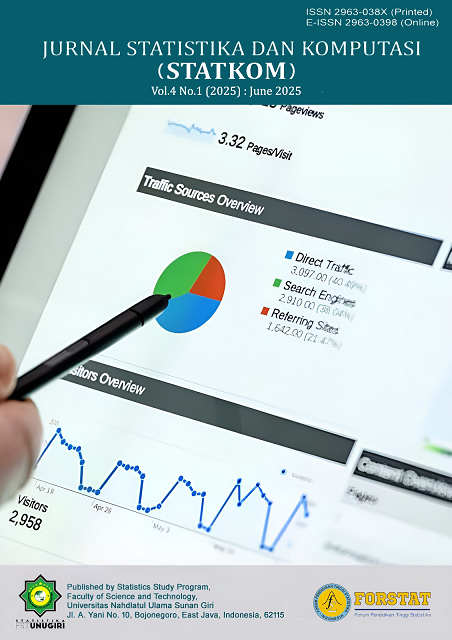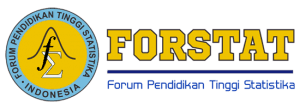Peramalan Jumlah Barang Kereta Api di Indonesia Menggunakan Metode Seasonal Autoregressive Integrated Moving Average (SARIMA)
 PDF Download: 290
SIMILARITY INDEX Download: 0
PDF Download: 290
SIMILARITY INDEX Download: 0
DOI:
https://doi.org/10.32665/statkom.v4i1.4424Keywords:
Goods Transportation, Time Series, SARIMA, MAPEAbstract
Background: Freight transportation is an important part of the business run by PT Kereta Api Indonesia. To support effective strategic planning and infrastructure development, an accurate prediction of the amount of goods to be transported in the future is required. Therefore, historical data-based forecasting methods such as Seasonal Autoregressive Interated Moving Average (SARIMA) can be a relevant approach to predict the number of railway goods in Indonesia.
Objective: Obtain a suitable model to forecast the number of goods transported by rail transportation in Indonesia, and to determine the results of the forecasting.
Methods: This research uses the time series method with the Seasonal Autoregressive Integrated Moving Averang (SARIMA) model approach based on data characteristics that show seasonal patterns. SARIMA itself is able to integrate seasonal pattern components in the data and is able to effectively capture periodic and structural dynamics in seasonal data.
Results: The best model obtained is probabilistic SARIMA(0,1,1)(0,1,1)12, using secondary data sourced from the Central Bureau of Statistics (BPS) in the range of January 2013 to March 2024. Forecasting for the next 12 months (April 2023 to March 2024) shows a Mean Absolute Percentage Error (MAPE) value of 8.03% which indicates that the level of forecasting accuracy is very good.
Conclusion: The probabilistic ARIMA(0,1,1)(0,1,1)12 model can be used as a reliable reference in predicting the amount of goods transported through rail transportation in Indonesia.
References
Abebe, T. H. (2020). Time Series Analysis of Monthly Average Temperature and Rainfall Using Seasonal ARIMA Model ( in Case of Ambo. International Journal of Theoretical and Applied Mathematics, 6(5), 76–87. https://doi.org/10.11648/j.ijtam.20200605.13
Fitriani, I., Arum P.R., & Amri, S. (2024). Pemodelan Seasonal Autoregressive Integrated Moving Average (SARIMA) untuk Meramalkan Volume Angkutan Barang Kereta Api di Pulau Jawa Tahun 2021: Memberikan prediksi volume angkutan barang kereta api di pulau jawa untuk masa mendatang. Journal Of Data Insights, 2(1), 26–35. https://doi.org/10.26714/jodi.v2i1.167
Astuti, S. W., & Jamaludin. (2018). Forecasting Surabaya - Jakarta Train Passengers with SARIMA model. IOP Conference Series: Materials Science and Engineering, 407(1). https://doi.org/10.1088/1757-899X/407/1/012105
Brata, A. S., Anhar, A., Lestari, W., Trisanti, Y., & Nisa, F. (2022). Metode Fuzzy Time Series Logika Ruey Chyn Tsaur untuk Prediksi Pola Data Trend Naik: Studi Kasus Pengiriman Jumlah Berat Barang dengan Transportasi Kereta Api Pulau Jawa Satuan Ribu Ton Tahun 2020 - 2022. Journal of Mathematics Education and Science, 6(1), 29–35. https://doi.org/10.32665/james.v6i1.887
Cania, S., Putri, D. M., & Rianjaya, I. D. (2023). Penerapan Model Seasonal Autoregressive Integrated Moving Average (SARIMA) pada Jumlah Penumpang Kereta Api di Sumatera Barat. JOSTECH: Journal of Science and Technology, 3(2), 209–220. https://doi.org/10.15548/jostech.v3i2.6880
Feng, F., Li, W., & Jiang, Q. (2018). Railway freight volume forecast using an ensemble model with optimised deep belief network. IET Intelligent Transport Systems, 12(8), 851–859. https://doi.org/10.1049/iet-its.2017.0369
Hyndman, R. J., & Athanasopoulos, G. (2021). Forecasting: Principles and Practice (3rd editon). OTexts: Melbourne. https://otexts.com/fpp3/
Ardiansah, I., Adiarsa, I. F., Putri, S. H., & Pujianto, T. (2021). Penerapan Analisis Runtun Waktu pada Peramalan Penjualan Produk Organik menggunakan Metode Moving Average dan Exponential Smoothing. Jurnal Teknik Pertanian Lampung (Journal of Agricultural Engineering), 10(4), 548. https://doi.org/10.23960/jtep-l.v10i4.548-559
Khoiriyah, N. S., Silfiani, M., Novelinda, R., & Rezki, S. M. (2023). Peramalan Jumlah Penumpang Kapal di Pelabuhan Balikpapan dengan SARIMA. Jurnal Statistika Dan Komputasi, 2(2), 76–82. https://doi.org/10.32665/statkom.v2i2.2303
Leksono, B. E. (2023). Peramalan Volume Angkutan Bahan Bakar Minyak Pt Kereta Api Indonesia (Persero) Daop V Purwokerto Dengan Metode Moving Average. Jurnal Pabean, 5(2), 138–145. https://doi.org/10.61141/pabean.v5i2.421
Memon, M. A., Thurasamy, R., Ting, H., & Cheah, J. H. (2025). Purposive Sampling: a Review and Guidelines for Quantitative Research. Journal of Applied Structural Equation Modeling, 9(1), 1–23. https://doi.org/10.47263/JASEM.9(1)01
Nashrullah, M., Maharani, O., Rohman, A., Fahyuni, E. F., Nurdyansyah, & Untari, R. S. (2023). Metodologi Penelitian Pendidikan Prosedur Penelitian, Subyek Penelitian, dan Pengembangan Teknik Pengumpulan Data. UMSIDA Press. https://press.umsida.ac.id/index.php/umsidapress/article/download/978-623-464-071-7/1117
Ratnaningsih, D. J., & Adam, F. F. (2024). Model Comparison of Vector Autoregressive Reshaped and Sarima in Seasonal Data (a Case Study of Tea Production in Pt Perkebunan Nusantara Viii Indonesia). Media Statistika, 16(2), 215–226. https://doi.org/10.14710/medstat.16.2.215-226
Rizal, M., & Sri Utami Zuliana. (2023). Forecasting Using Sarima And Bayesian Structural Time Series Method For Range Seasonal Time. Proceedings of The International Conference on Data Science and Official Statistics, 2023(1), 382–391. https://doi.org/10.34123/icdsos.v2023i1.402
Sartono. (2016). Pemodelan untuk Pengiriman Barang dengan Memanfaatkan Jasa Kereta Api di Jawa dan Sumatera. Konferensi Nasional Penelitian Matematika Dan Pembelajarannya (KNMP I), Knpmp I, 790–799. https://proceedings.ums.ac.id/knpmp/article/view/2569
Suryadi, S. (2019). Kinerja dan Peramalan Pertumbuhan Angkutan Kereta Api Menggunakan Model SARIMA. Warta Penelitian Perhubungan, 26(7), 381–392. https://doi.org/10.25104/warlit.v26i7.922%0A
Susilawati, R., & Sunendiari, S. (2022). Peramalan Jumlah Penumpang Kereta Api Menggunakan Metode Arima dan Grey System Theory. Jurnal Riset Statistika, 2(1), 1–12. https://doi.org/10.29313/jrs.vi.603
Downloads
Additional Files
Published
How to Cite
Issue
Section
License
Copyright (c) 2025 Idrus Syahzaqi, Sediono Sediono, Sabrina Salsa Oktavia, Aurellia Calista Anggakusuma, Ezha Easyfa Wieldyanisa

This work is licensed under a Creative Commons Attribution-ShareAlike 4.0 International License.
Authors who publish with this journal agree to the following terms:
- Authors retain copyright and grant the journal right of first publication with the work simultaneously licensed under a Creative Commons Attribution License - Share Alike that allows others to share the work with an acknowledgment of the work's authorship and initial publication in this journal.
- Authors are able to enter into separate, additional contractual arrangements for the non-exclusive distribution of the journal's published version of the work (e.g., post it to an institutional repository or publish it in a book), with an acknowledgment of its initial publication in this journal.
- Authors are permitted and encouraged to post their work online (e.g., in institutional repositories or on their website) prior to and during the submission process, as it can lead to productive exchanges, as well as earlier and greater citation of published work.
USER RIGHTS
All articles published Open Access will be immediately and permanently free for everyone to read and download. We are continuously working with our author communities to select the best choice of license options, currently being defined for this journal as follows:
 PDF Download: 290
SIMILARITY INDEX Download: 0
PDF Download: 290
SIMILARITY INDEX Download: 0













